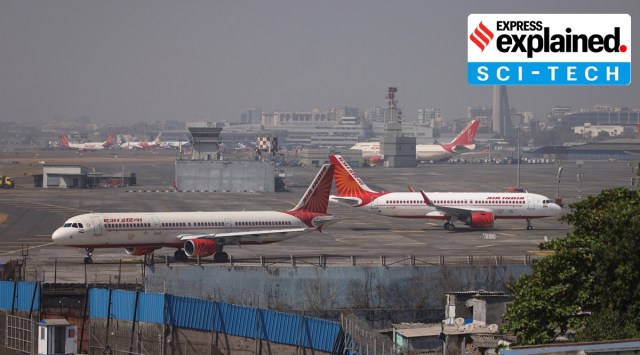Latest Comment
Post Comment
Read Comments
 Air India passenger aircraft seen on the tarmac at Chhatrapati Shivaji International airport in Mumbai. (Reuters)
Air India passenger aircraft seen on the tarmac at Chhatrapati Shivaji International airport in Mumbai. (Reuters) Air India’s massive order for 470 new aircraft, announced on Tuesday, is split between Airbus and Boeing. The Tata Group-owned carrier will buy 250 jets from the Toulouse-based Airbus and 220 jets from the Seattle-based Boeing. While the majority of the order (400 jets) comprises narrow body jets, the highlight of the order are the 70 widebody jets ordered.
The Airbus order includes 40 of the widebody A350s — six A350-900 and 34 A350-1000. For the first time, a widebody from the Airbus family joins the fleet of Air India, which currently only operates Boeing widebodies, the 777 and 787.
The Boeing order includes 20 widebody Boeing 787 or Dreamliners and 10 Boeing 777X, another widebody, long-haul jet. The 777X is a new plane, which is still in the testing stage and is yet to enter service. Air India becomes the 11th named customer for the 777X.
We take an individual look at the “jumbo jets” ordered by Air India.
Airbus developed the A350 as a rival to Boeing’s 787 or Dreamliner.
It has two variants, the A350-900 and A350-1000, which has a longer fuselage. The long-range jet can carry 300-410 passengers in a typical three-class seating and up to 480 passengers in a single-class seating. The cabin air is renewed every 2-3 minutes, according to the company’s website.
Like the Dreamliner, the A350’s airframe and wings are made of composites. More than 70 per cent of the airframe uses composites, titanium and aluminium, making the plane lighter, cost-efficient and requiring less maintenance. It is powered by two Rolls-Royce Trent XWB engines.
The A350 entered service on January 15, 2015, with Qatar Airways.
The Boeing 787 Dreamliner entered commercial service with the All Nippon Airways in 2011.
It has three variants, 787-8, 787-9 and 787-10 which differ from each other on the basis of size and range. According to the company’s website, the aircrafts can fit between 248 to 336 passengers in a two class formation and have a range of up to 14,000 km. It is powered by two General Electric GEnx-1B / Trent 1000 engines. The 787 was the first commercial aircraft to have an airframe majority made of carbon fiber reinforced polymer (CFRP).
While this raised durability and resilience concerns, it contributed to a significant reduction in fuel burn – thus making the aircraft “cleaner” as well as more cost-effective.
Yet to be certified and enter service, the 777X draws the best from Boeing’s highly successful 777, which entered service in 1995, and the more recent 787.
Longer than and seen as a competitor to the A350-1000, the 777X features folding wingtips, a first on a commercial aircraft, which will allow it to be in service in smaller airports as well. The aircraft is powered by two General Electric GE9X powerplants.
The 777X, likely to enter service in 2025, comes in two variants: the 777-8 and 777-9. The 777-8, with a range of 8,730 nautical miles, can carry up to 384 passengers. The 777-9 can carry up to 426 passengers and has a range of 7,285 nautical miles, according to the company’s website.
This is not the first time when an aircraft manufacturer has received orders for a new aircraft much before it is finally ready for service. Often, manufacturers design and develop an aircraft or a variant in consultation with potential customers. There has to be a market for the new product, which requires huge investment. For instance, in the sixties, Boeing went ahead with designing and building the iconic 747, a completely new aircraft, only after being convinced by Pan Am about the need of a massive long-haul jet.
Wide-body aircraft, sometimes called jumbo jets, are those airplanes that have a fuselage with a width that usually falls in the range of 16 to 20 feet (4.8 to 6.1 meters) in diameter. Boeing 747 was the first widebody jet, introduced in 1969.
The disadvantages of widebody jets are obvious – the burn more fuel, need longer runways to take off, bigger hangars to store, and in general, are more expensive to operate. In today’s ultra-competitive aviation sector, this might seem to put off many customers. Yet, companies like Boeing and Airbus are constantly innovating in this space as well as receiving plenty of orders of widebody aircraft.
The main advantages of widebody aircraft are the increased passenger and cargo capacity, as well as higher stability in flight. The airline needs to balance these benefits with the cons of operating widebody jets. Air India’s order indicates a move towards overseas expansion as it is in long-haul international flights that widebody jets excel.
In 2022, Air India had also announced that it was going to bring back 10 grounded widebody jets in its fleet by 2023.